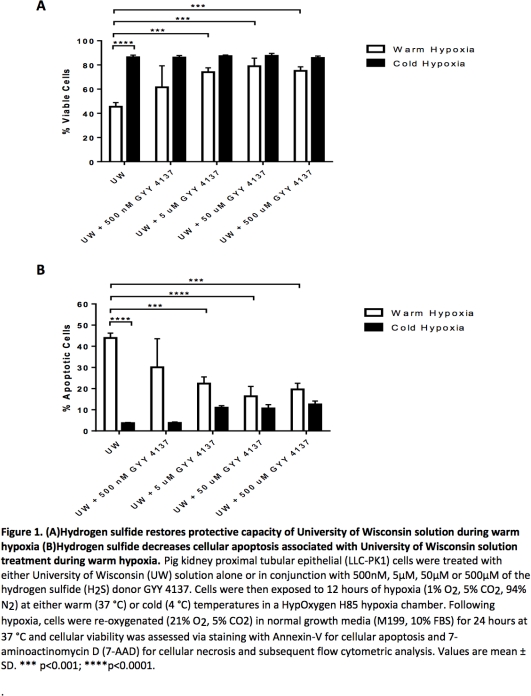Hydrogen Sulfide Restores Protective Capacity of University of Wisconsin Solution During Normothermic Preservation
1Microbiology & Immunology, University of Western Ontario, London, ON, Canada
2Matthew Mailing Centre for Translational Transplant Studies, London Health Sciences Centre, London, ON, Canada
3Experimental Therapeutics, University of Exeter Medical School, Exeter, England, United Kingdom.
Meeting: 2015 American Transplant Congress
Abstract number: 218
Keywords: Perfusion solutions, Warm ischemia
Session Information
Session Name: Concurrent Session: Kidney: Surgical Technique/Complications
Session Type: Concurrent Session
Date: Monday, May 4, 2015
Session Time: 2:15pm-3:45pm
 Presentation Time: 3:15pm-3:27pm
Presentation Time: 3:15pm-3:27pm
Location: Room 115-AB
Organ preservation solution is crucial in mitigating effects of ischemia reperfusion injury (IRI) associated with transplantation. Although University of Wisconsin (UW) solution is ideally suited for cold organ storage, it cannot be used in the setting of newly developing normothermic perfusion strategies. We have previously shown that supplementation of cold UW solution with hydrogen sulfide (H2S), an endogenously produced gasotransmitter, minimizes IRI in murine models of transplantation. This study aims to investigate if H2S supplementation could impart a protective effect on UW solution during warm hypoxia/reoxygenation, thus allowing its use in normothermic perfusion.
Methods
Porcine renal proximal tubular epithelial cells (LLC-PK1;ATCC) grown in M199 media with 10% fetal bovine serum(FBS) were treated with UW solution containing 500nM, 5uM, 50uM or 500uM of GYY 4137 (slow releasing H2S donor).Treated cells were placed in hypoxia chamber(1%O2,5%CO2,94%N2) for 12 hours at 370C(warm) or 40C(cold) followed by 24 hours of reperfusion in M199(10%FBS) media in an incubator(21%O2,5%CO2,370C). Cell viability and apoptosis was assessed using flow cytometry.
Results
UW solution protected LLC-PK1 cells in cold hypoxia as exhibited by significantly decreased apoptosis and significantly increased viability compared to the warm hypoxic group(p<0.05). While the addition of GYY 4137 to cold UW solution did not change cellular viability, increasing concentrations of GYY 4137 in UW solution under warm hypoxia significantly increased viability and significantly decreased cellular apoptosis compared to untreated cells (p<0.05).
Conclusion
This study is the first to show that supplementation of UW solution with H2S can preserve cell viability under normothermic hypoxia/reoxygenation. These findings could potentially augment normothermic organ preservation techniques using existing preservation solutions to ultimately improve renal transplant outcomes.
To cite this abstract in AMA style:
Grewal J, Lobb I, Whiteman M, Sener A. Hydrogen Sulfide Restores Protective Capacity of University of Wisconsin Solution During Normothermic Preservation [abstract]. Am J Transplant. 2015; 15 (suppl 3). https://atcmeetingabstracts.com/abstract/hydrogen-sulfide-restores-protective-capacity-of-university-of-wisconsin-solution-during-normothermic-preservation/. Accessed December 13, 2025.« Back to 2015 American Transplant Congress
